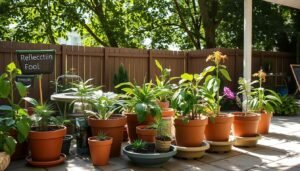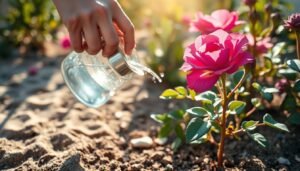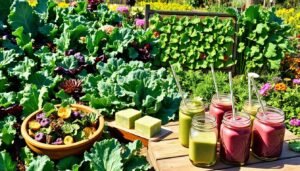In the world of botany, are there plants referred to as scrubs often means various resilient plants that thrive in tough conditions, like dry climates or poor soil. Scrub plants are specially adapted to survive in challenging environments, showcasing the unique qualities of these areas.
Scrub habitats play a crucial role in maintaining ecological balance. They support diverse plant and animal life, offering essential benefits to our planet. Exploring are there plants referred to as scrubs highlights the resilience of these plants and the valuable lessons they provide on survival in harsh conditions.
Key Takeaways
- Scrubland vegetation includes diverse plant communities thriving despite harsh conditions.
- Characteristics of scrub plants often involve drought tolerance and adaptability to poor soils.
- These ecosystems support a large number of animal species, contributing to biodiversity.
- The term “scrub” reflects various botanical definitions, highlighting ecological significance.
- Understanding scrub habitats helps appreciate their role in global environmental health.
Table of Contents
Understanding the Term “Scrub” in Botany
The botanical term scrub refers to a specific plant community. It is made up of low-growing, woody plants, mainly shrubs. Scrubs grow well in poor soil and with little water. Learning about scrubs shows how they can thrive in tough places.
Scrubs are important for keeping nature in balance. They are defined by their shape. Shrubs, which are the main plants, are under 8 meters tall. There are different sizes of shrubs, from very small to tall.
There are many types of scrubs, like chaparral in California or maquis in France. In Australia, shrublands are sorted by how plants look and how much foliage they have. These ways of sorting help us see how important scrubs are.
Scrub habitats can change a lot. Some areas stay scrubland for a long time. Others may turn into scrub after a fire. Many shrubs can grow new plants after a fire. This shows how scrubs can bounce back.
Understanding scrubs helps us see their role in nature. Their unique features and where they grow add to the variety of life in these places.
Are There Plants Referred to as Scrubs?
Yes. Many plants are called scrubs. They have special scrub characteristics that help them grow in different places. These plants can grow up to 12 to 15 feet tall. They have many stems and can live in poor soil and dry seasons.
Defining Scrubs and Their Characteristics
Scrub characteristics show how these plants have many stems. For example, blackthorn and gorse have spines to keep animals away. Dog rose uses thorns to climb over other plants. These plants help fight climate change by taking in carbon dioxide.
But, urban areas and farming are hurting these habitats. It’s important to save these places for future generations.
Types of Plants Commonly Found in Scrub Communities
There are many scrub plant types around the world. In dry places, scrub oaks and Florida rosemary grow well. Desert scrublands have tough plants like those in the American Southwest.
Other important plants include gallberry and saw palmetto. They add to the variety of life in scrub areas.
Pioneer plants are key because they produce lots of seeds. These seeds help new areas grow quickly. Plants like hawthorn, elder, and bramble do well in different soils. This shows how diverse scrub ecosystems are.
If you like gardening and caring for the earth, check out BeeGreenGarden. Learning about scrublands helps us understand our world better.
Scrubland Vegetation: An Overview
Scrubland vegetation is a fascinating mix of life that grows in tough spots. It’s home to many plant species that have adapted to their surroundings. This shows the rich variety of life in scrublands.
Scrublands are found in areas with drought, poor soil, and extreme weather. They have developed strong connections between each other. This shows their key role in the ecosystem.
The Biodiversity of Scrublands
Scrubland ecosystems are full of different plants and animals. Many shrubland areas support hundreds of species. This creates complex networks that help these ecosystems stay healthy.
In places like Australia, scrublands face big challenges. About 90% of valuable rangelands have degraded due to human actions.
Ecological Importance of Scrub Plant Species
The plants in scrublands are very important. They help keep the soil in place, stop erosion, and support wildlife. Some plants have special seeds that wait until it’s better to grow.
This helps them survive and grow back after fires. In Mediterranean areas, scrublands have replaced forests due to tree cutting, heavy grazing, and soil erosion. We need to protect these areas. For more info, check out this article.
Exploring the Chaparral Biome
The chaparral biome is a special place with plants that love the dry Mediterranean weather. It’s full of shrubs with hard, waxy leaves. These leaves help the plants save water during dry times.
Characteristics of the Chaparral Ecosystem
In this biome, I see many special features. The plants grow close together, making it hard to walk through. They have:
- Two-layered root systems to get water from deep and shallow soil.
- Dense foliage to protect against drought and fire.
- Resistance to fire, with many plants able to grow back after a fire.
Common Plant Species in Chaparral Regions
The chaparral biome has many plants that are very tough. Some of these plants are:
- Chamise (Adenostoma fasciculatum) is often the most common plant.
- Sagebrush (Artemisia spp.) can handle dry weather well.
- Manzanita (Arctostaphylos spp.) has smooth red bark and stays green all year.
Exploring this biome, I see how these plants help make it rich and diverse. They show how the chaparral is not just a home for animals but also a key part of nature.
Mediterranean Scrub: Climate and Vegetation
The Mediterranean scrub is a special place with its own weather and plants. It has hot, dry summers and cool, wet winters. This makes it a perfect home for many plants.
More than 10% of the world’s plants live here. This shows how important these places are for keeping nature diverse.
Adaptations of Mediterranean Scrub Plants
Plants in the Mediterranean scrub have special ways to survive. They have:
- Thick, waxy leaves: These help them not lose too much water when it’s dry.
- Deep root systems: Roots reach deep into the soil for water.
- Seasonal growth cycles: Some plants sleep during the driest months to save energy.
- Fire-resistant features: Some plants can grow back quickly after fires.
Differences Between Mediterranean and Other Scrub Types
Mediterranean scrub is different from other scrub types. It has its own special weather and plants. Places like California and South Africa have similar areas, but they are not the same.
Mediterranean scrub is only 1% of the Earth’s surface. But it’s very important for studying nature. It shows how unique and important these areas are.
Coastal Sage Scrub: Unique Ecosystem Features

The coastal sage scrub is a special place. It can handle dry conditions well. It’s home to many different plants and animals.
This area is along the California coast. It has a special mix of features that help many unique species live here. Over 150 years, humans have changed this place a lot. This has hurt the habitat, so we need to protect it.
Typical Flora and Fauna in Coastal Sage Scrub
In the Baldwin Hills, you can find native plants like California Sagebrush and Coyote Brush. There’s also Prickly-pear Cactus. This greenery is important for many animals.
- Yellow-rumped Warbler: This bird comes to the area in winter. You can see it at Kenneth Hahn and West LA College.
- California Quail: This bird loves the scrub and can be found in local parks.
- Bushtit: These birds look for insects in the scrub. They show how important this place is for small birds.
- Bewick’s Wren: This bird is known for its song. It shows how wildlife has adapted to the coastal sage scrub.
These animals show why the coastal sage scrub is so important. It’s a key place for them to find food and make homes.
Conservation Efforts for Coastal Sage Habitats
As cities grow, the coastal sage scrub is in danger. Groups like the DMARLOU Foundation and the National Fish and Wildlife Foundation are working to save it. They are doing things like:
- Trying to stop the loss of habitat because of cities.
- Watching the bird populations to keep them from disappearing.
- Working on big plans to protect areas like the South Coast and Central Coast.
They are also learning more about the plants and animals here. They found that about 20% of the plants are not native. This means they need to keep a close eye on things. Their work helps make sure the coastal sage scrub stays healthy for the future.
| Species | Habitat Preference | Observation Locations |
|---|---|---|
| California Sagebrush | Arid, well-drained soils | Baldwin Hills |
| Yellow-rumped Warbler | Deciduous shrubs | Kenneth Hahn, West LA College |
| California Quail | Thick shrub cover | Kenneth Hahn, Culver City Park |
| Bushtit | Dense scrub habitat | Baldwin Hills, local parks |
Maquis Shrubland: Characteristics and Locations
Maquis shrubland is a unique place, especially in the Mediterranean. It’s filled with dense, evergreen shrubs that grow well in poor soil. This lets many plants live in tough conditions.
Maquis habitats are found near the Mediterranean Sea, in southern France, Italy, and Spain. They also exist in North Africa and California. These places are key for keeping many plants and animals alive.
The way these ecosystems work supports a wide range of Mediterranean plants. The shrubs help different species work together, making these places very diverse. It’s amazing to see how plants and animals survive and grow here.
Studying maquis shrublands teaches us a lot about how plants adapt and ecosystems work. These areas are very important. They help keep the Mediterranean landscapes full of life and need our protection.
Fynbos Shrubland: A Global Perspective
The fynbos shrubland is a treasure of nature, full of diverse plants. It’s found in the Western Cape of South Africa. This area is home to many plants that are found nowhere else.
It has nearly 6,000 species that are unique to this place. This makes it a key part of the world’s plant diversity.
Distinctive Plants of Fynbos Ecosystems
Looking at the plants in the fynbos, we see amazing diversity. There are over 9,000 plant species here. This includes more than 600 Erica species, many of which are only found here.
Also, the fynbos is home to over 1,400 bulb species. This includes many Gladiolus and Lachenalia. Table Mountain alone has 2,200 plant species, more than the UK has.
Fynbos Biome and Its Role in Biodiversity
The fynbos biome is crucial for biodiversity. It covers only 6% of southern Africa but has half of the continent’s plant species. It’s a key place for many unique plants.
It also supports important plants like Rooibos and Honeybush. But, human activities threaten this biodiversity. We need to work hard to save these habitats.
| Characteristic | Detail |
|---|---|
| Area covered | 6% of southern Africa |
| Total plant species | Over 9,000 |
| Endemic plant species | About 6,200 |
| Species on Table Mountain | 2,200 species |
| Ericas species | Over 600 species |
| Notable bulb species | 96 Gladiolus, 54 Lachenalia |
| Ecological threats | Human habitation, agriculture, invasive species |
Batha Scrubland: Ecology and Flora
Batha scrubland is found mainly in the Mediterranean Basin. It’s known for its batha flora. This area has many hard-leaved, evergreen shrubs that grow well in dry places. These plants show how life can thrive in harsh conditions.
The plants in batha scrubland come in different sizes. Some are short and open, while others are tall and dense. These plants have special features that help them save water in dry times.
It’s interesting to see how similar the plants are in different places. For example, southwestern California, west-central Chile, and South Africa’s western Cape Province all have similar shrubs. These areas also have grasslands with unique plants. This shows a complex web of life that’s worth studying.
Batha scrubland is important for saving biodiversity. Its tough plants support animals and help fix damaged land. They also give resources to local people. Here are some key facts about batha scrubland’s plants and their role in the ecosystem:
| Characteristic | Value |
|---|---|
| Region of Occurrence | Mediterranean Basin, Southwestern California, West-Central Chile, Western Cape of S. Africa, Southwestern and Southern Australia |
| Height Range of Shrubs | 0.5 m to 5 m |
| Prevalent Growth Form | Sclerophyll-leaved shrubs |
| Unique Adaptive Traits | Water conservation mechanisms, resilience to aridity |
| Endemism Percentage | Varies by region, often above 30% |
Mallee Scrub: An Australian Hotspot
The mallee scrub is a special place in Australia. It’s known for its unique ways to live in dry places. This scrub grows well in areas with little water, showing it can handle tough conditions.
Adaptations of Mallee Plants to Arid Conditions
Mallee plants have special traits to help them survive in dry places. Some of these include:
- Multiple Stems: Mallee plants have many stems. This helps them grow back fast after fires. It’s a key way they stay alive and grow again.
- Drought Resistance: They have thick, waxy leaves to save water. This is important in places with little rain.
- Extensive Root Systems: Mallee plants have deep roots. These roots find water deep underground. This helps them stay strong during long dry times.
- Seed Dormancy: Some mallee plants make seeds that wait for the right time to grow. This helps them keep going even when the weather changes.
These special ways help the mallee scrub stay full of life. By learning about these traits, we see how life can thrive in harsh places. The way different plants work together in this area is key to Australia’s health.
Semi-Arid Scrubland: Environmental Conditions
Semi-arid scrubland is a special area between true deserts and greener places. It has its own set of conditions that affect the plants that live there. The little water and big temperature changes make it hard for plants to grow well.
Species Composition in Semi-Arid Regions
The types of plants in semi-arid scrublands change a lot. This is because of the soil and how much water it holds. Succulents are common because they can handle the dry weather well. Their roots are shallow, helping them grab water quickly before it all evaporates.
Shrubs like Ephedra californica are key to these areas. They help more plants grow and keep the area diverse. But, as deserts grow, these scrublands face big threats from pollution and other damage.
Studying shrubs and other plants helps us understand these ecosystems better. Shrubs help by trapping seeds and protecting plants from harm. A study in California’s Panoche-Coalinga Area shows how droughts affect shrubs and plants, showing the challenges of changing weather.
| Environmental Condition | Impact on Species Composition |
|---|---|
| Moisture Availability | Influences the growth of shallow-rooted plants; promotes succulents |
| Temperature Extremes | Drives adaptations in plant physiology and structure |
| Soil Types | Determines vegetation types based on nutrient content and drainage |
| Human Impact | Can either degrade or promote recovery in shrubland ecosystems |
Conclusion
Scrubs are amazing ecosystems with unique plants and special ways to survive. We’ve looked at different types, like coastal sage scrub and Mediterranean scrub. These places are key for many plants and animals, helping the environment in big ways.
They protect soil, absorb carbon, and connect habitats. This is why saving scrublands is so important. Many plants, like scrub mint, are in danger because of lost homes, fires, and bad management.
Efforts to save scrub mint show the big challenges these areas face. Only 5 of the 14 known scrub mint spots are safe. This makes it clear we need to act fast to save these important places.
Learning about the plants in scrub ecosystems helps us value them more. We must work to protect these areas. This will help our environment stay healthy and strong.




